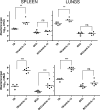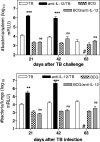Increased pulmonary tumor necrosis factor alpha, interleukin-6 (IL-6), and IL-17A responses compensate for decreased gamma interferon production in anti-IL-12 autovaccine-treated, Mycobacterium bovis BCG-vaccinated mice
- PMID: 21084465
- PMCID: PMC3019790
- DOI: 10.1128/CVI.00352-10
Increased pulmonary tumor necrosis factor alpha, interleukin-6 (IL-6), and IL-17A responses compensate for decreased gamma interferon production in anti-IL-12 autovaccine-treated, Mycobacterium bovis BCG-vaccinated mice
Abstract
Interleukin-12 (IL-12) and IL-23 (which share a p40 subunit) are pivotal cytokines in the generation of protective Th1/Th17-type immune responses upon infection with the intracellular pathogen Mycobacterium tuberculosis. The role of IL-12 and IL-23 in protection conferred by the tuberculosis vaccine Mycobacterium bovis bacillus Calmette-Guérin (BCG) is, however, less well documented. By using an autovaccine approach, i.e., IL-12p70 cross-linked with ovalbumin and PADRE peptide formulated with the GSK proprietary adjuvant system AS02(V), we could specifically neutralize IL-12 while leaving the IL-23 axis intact. Neutralization of IL-12 before M. tuberculosis challenge rendered C57BL/6 mice highly susceptible, resulting in 30-fold-higher CFU in spleen and lungs and accelerated mortality. In contrast, neutralization of IL-12 in BCG-vaccinated mice prior to M. tuberculosis challenge only marginally affected vaccine-mediated protection. Analysis of cytokine production in spleen and lungs 3 weeks post-TB challenge by enzyme-linked immunosorbent assay and functional and flow cytometric assays showed significantly reduced mycobacterium-specific gamma interferon (IFN-γ) responses in M. tuberculosis-infected and BCG-vaccinated mice that had been treated with the autovaccine. Purified protein derivative-induced tumor necrosis factor alpha (TNF-α), IL-6, and IL-17A levels, however, were highest in lungs from BCG-vaccinated/IL-12-neutralized animals, and even unstimulated lung cells from these mice produced significant levels of the three cytokines. Mycobacterium-specific IL-4 and IL-5 production levels were overall very low, but IL-12 neutralization resulted in increased concanavalin A-triggered polyclonal secretion of these Th2-type cytokines. These results suggest that TNF-α, IL-6, and IL-17A may be more important pulmonary effector molecules of BCG-mediated protection than IFN-γ in a context of IL-12 deficiency.
Figures








Similar articles
-
Blockade of IL-10 signaling during bacillus Calmette-Guérin vaccination enhances and sustains Th1, Th17, and innate lymphoid IFN-γ and IL-17 responses and increases protection to Mycobacterium tuberculosis infection.J Immunol. 2012 Oct 15;189(8):4079-87. doi: 10.4049/jimmunol.1201061. Epub 2012 Sep 12. J Immunol. 2012. PMID: 22972927 Free PMC article.
-
A booster vaccine expressing a latency-associated antigen augments BCG induced immunity and confers enhanced protection against tuberculosis.PLoS One. 2011;6(8):e23360. doi: 10.1371/journal.pone.0023360. Epub 2011 Aug 17. PLoS One. 2011. PMID: 21858087 Free PMC article.
-
Recombinant Mycobacterium bovis bacillus Calmette-Guérin (BCG) expressing mouse IL-18 augments Th1 immunity and macrophage cytotoxicity.Clin Exp Immunol. 2004 Jul;137(1):24-34. doi: 10.1111/j.1365-2249.2004.02522.x. Clin Exp Immunol. 2004. PMID: 15196240 Free PMC article.
-
T cells and cytokines in intracellular bacterial infections: experiences with Mycobacterium bovis BCG.Ciba Found Symp. 1995;195:123-32; discussion 132-6. doi: 10.1002/9780470514849.ch9. Ciba Found Symp. 1995. PMID: 8724834 Review.
-
Is mapping the BCG vaccine-induced immune responses the key to improving the efficacy against tuberculosis?J Intern Med. 2020 Dec;288(6):651-660. doi: 10.1111/joim.13191. Epub 2020 Nov 19. J Intern Med. 2020. PMID: 33210407 Free PMC article. Review.
Cited by
-
Multifunctional CD4 cells expressing gamma interferon and perforin mediate protection against lethal influenza virus infection.J Virol. 2012 Jun;86(12):6792-803. doi: 10.1128/JVI.07172-11. Epub 2012 Apr 4. J Virol. 2012. PMID: 22491469 Free PMC article.
-
Mice genetically inactivated in interleukin-17A receptor are defective in long-term control of Mycobacterium tuberculosis infection.Immunology. 2013 Oct;140(2):220-31. doi: 10.1111/imm.12130. Immunology. 2013. PMID: 23721367 Free PMC article.
-
Vaccines displaying mycobacterial proteins on biopolyester beads stimulate cellular immunity and induce protection against tuberculosis.Clin Vaccine Immunol. 2012 Jan;19(1):37-44. doi: 10.1128/CVI.05505-11. Epub 2011 Nov 9. Clin Vaccine Immunol. 2012. PMID: 22072720 Free PMC article.
-
Dynamic balance of pro- and anti-inflammatory signals controls disease and limits pathology.Immunol Rev. 2018 Sep;285(1):147-167. doi: 10.1111/imr.12671. Immunol Rev. 2018. PMID: 30129209 Free PMC article. Review.
-
Th1/Th17 cell induction and corresponding reduction in ATP consumption following vaccination with the novel Mycobacterium tuberculosis vaccine MVA85A.PLoS One. 2011;6(8):e23463. doi: 10.1371/journal.pone.0023463. Epub 2011 Aug 26. PLoS One. 2011. PMID: 21887254 Free PMC article.
References
-
- Aggarwal, S., N. Ghilardi, M. H. Xie, F. J. de Sauvage, and A. L. Gurney. 2003. Interleukin-23 promotes a distinct CD4+ cell activation state characterized by the production of interleukin-17. J. Biol. Chem. 278:1910-1914. - PubMed
-
- Alexander, J., et al. 1994. Development of high potency universal DR-restricted helper epitopes by modification of high affinity DR-blocking peptides. Immunity 1:751-761. - PubMed
-
- Andersen, P., B. Gicquel, and K. Huygen. 2004. Tuberculosis vaccine science, p. 885-898. In W. N. Rom and S. M. Garay (ed.), Tuberculosis, 2nd ed. Lippincott Williams & Wilkins, Philadelphia, PA.
-
- Bean, A. G., et al. 1999. Structural deficiencies in granuloma formation in TNF gene-targeted mice underlie the heightened susceptibility to aerosol Mycobacterium tuberculosis infection, which is not compensated for by lymphotoxin. J. Immunol. 162:3504-3511. - PubMed
Publication types
MeSH terms
Substances
LinkOut - more resources
Full Text Sources

